9 AUGUST 2010
YOUR WORDS
Readers are invited to add their comments to any story. Click on the article to see and add.
BTN DISTRIBUTION
BTN also goes out by email every Sunday night at midnight (UK time). To view this edition click here.
The Business Travel News
PO Box 758
Edgware HA8 4QF
United Kingdom
info@btnews.co.uk
© 2022 Business Travel News Ltd.
Article from BTNews 9 AUGUST 2010
ON TOUR: Steam engine Tornado and a Brunel day out
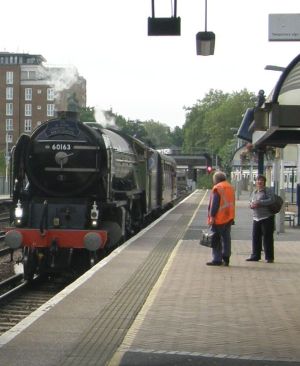 Those in the airline business are always worried by what is called ‘range and performance’, meaning how far will the aircraft fly carrying how much by way of passengers and freight. At London City, and other airports with restricted runways, you can add in ‘how high’ and ‘how long’, meaning where is the airport in terms of sea level and the runway length. These are crucial performance factors.
Those in the airline business are always worried by what is called ‘range and performance’, meaning how far will the aircraft fly carrying how much by way of passengers and freight. At London City, and other airports with restricted runways, you can add in ‘how high’ and ‘how long’, meaning where is the airport in terms of sea level and the runway length. These are crucial performance factors.
Now it may surprise readers but the Victorian railway engineers had the same problem too. OK it did not matter in terms of altitude (at least in England) but the trains of old consumed coal at a fast rate and, would you believe it, water too. Coal was no real problem, the onboard bunker just got larger, but water posed real difficulties. About 100 miles was all they could manage, or 5,000 gallons.
Someone then came up with a great idea. Water troughs, or high speed transfer systems in today’s parlance. All along the networks of old these were incorporated as part of the system, sat between the lines, with scoops on the actual engines.
With the demise of the steam locomotive they were all dug up.
This brings us neatly to 60163 Tornado, the first steam engine to be built in the UK since 1960. Tornado is a fascinating tale itself. Built at York, the spiritual home of railway engineering, it weighs 166 tons and is limited to 75mph. Its coal bunker holds seven tons. Prince Charles gave it a splendid send-off in August 2008. She cost around £3m.
Our thanks go to the Amethyst Experience who invited AERBT to participate in one of their regular enthusiast excursions behind this mighty locomotive.
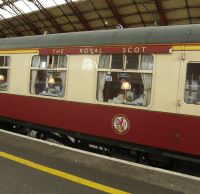 Ashford was the first passenger boarding point for the all Pullman style train with various pick-up points along the route. Our day started at one of London’s less well known stations, Kensington Olympia, and consisted of a return trip to Bristol Temple Meads, the terminus for ‘Gods Wonderful Railway’ GWR.
Ashford was the first passenger boarding point for the all Pullman style train with various pick-up points along the route. Our day started at one of London’s less well known stations, Kensington Olympia, and consisted of a return trip to Bristol Temple Meads, the terminus for ‘Gods Wonderful Railway’ GWR.
Whilst waiting at Olympia for the train we were treated to the solo Tornado running along the same track. Soon after Olympia, at Old Oak Common, our train stopped, changing the diesel unit for the steam locomotive.
For those not into ‘railways’ the whole setup is interesting. Amethyst Experience is a marketing company who hire the engine and the carriages each separately, plus the specialist caterers, very experienced with train operations. The actual routing then has to be negotiated with Network Rail to ensure that Tornado can fit in with the timetabled services. Without the scoop previously mentioned watering has to be planned, a donation to a local fire brigade en-route sorting that one out. However National Rail has to find a siding that the rail set can fit into.
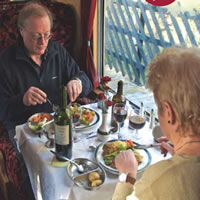 With Bucks Fizz to send the day off plus breakfast and a light lunch served in style, the journey passes very quickly, Heathrow Express riders finding it very odd as they pass what is termed ‘The Bath & Bristol Explorer’ building up speed on the main line towards Hayes. The ride is smoother than that experienced with the Orient Express carriages.
With Bucks Fizz to send the day off plus breakfast and a light lunch served in style, the journey passes very quickly, Heathrow Express riders finding it very odd as they pass what is termed ‘The Bath & Bristol Explorer’ building up speed on the main line towards Hayes. The ride is smoother than that experienced with the Orient Express carriages.
For some the outward journey was complete at Bath, with plenty of hours to explore that most interesting of cities. AERBT stayed on board arriving at Bristol in plenty of time to take the short walk to the Avon Ferry, cruise through the city centre, and a visit to the SS Great Britain. Very relaxing and most pleasant.
Anyone interested in transport over the ages ought to make SS Great Britain a MUST when visiting Bristol.
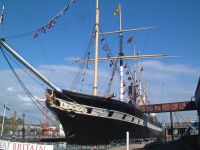 When launched in 1843, she was by far the largest vessel afloat. The genius behind the project was once again the GWR man Isambard Kingdom Brunel, Prince Albert taking the train from London to initiate the ship. She could carry up to 750 passengers and was well ahead of her time. Whilst the ship certainly had her problems during the early days she is best known for a regular service to Australia, but finished her days as a coal hulk in the Falkland Islands in the 1880s.
When launched in 1843, she was by far the largest vessel afloat. The genius behind the project was once again the GWR man Isambard Kingdom Brunel, Prince Albert taking the train from London to initiate the ship. She could carry up to 750 passengers and was well ahead of her time. Whilst the ship certainly had her problems during the early days she is best known for a regular service to Australia, but finished her days as a coal hulk in the Falkland Islands in the 1880s.
Fast forward to 1970 and still afloat. Funds were established for her to be brought back to her place of birth, the dry dock in the Great Western Dockyard Bristol.
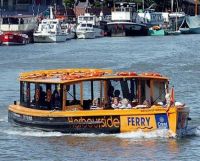 Today she is open to the public, 200,000 a year, and a wonderful memorial to Brunel himself, and the merchant seamen of 150 years ago.
Today she is open to the public, 200,000 a year, and a wonderful memorial to Brunel himself, and the merchant seamen of 150 years ago.
Time did not permit a close inspection of yet another example of Brunel’s engineering genius in Bristol, the Clifton Suspension Bridge.
The next Amethyst Experience takes place on Saturday 21 August and again starts at Ashford with stops until Kensington and thence on to the West Somerset Railway, a true country branch line with ten stations and its own historic steam locomotives, coaches and wagons. The trip takes in the gently rolling Quantock hills and unspoilt villages and farms, plus the Bristol Channel coast with views of distant South Wales, Dunster's imposing Castle and Minehead's seaside charm.
The Silver Service package is £219.00 per person including the Bucks Fizz welcome, a full English breakfast and light lunch, whilst on the way back a memorable five course freshly prepared dinner is served. There is a First Class deal with morning Coffee and Danish pastries outbound and tea and biscuits on the return at £159, or at the very back of the train Standard Class seating at £99. Bring your own food or pop into the bar. www.amethyst-experience.com www.ssgreatbritain.org
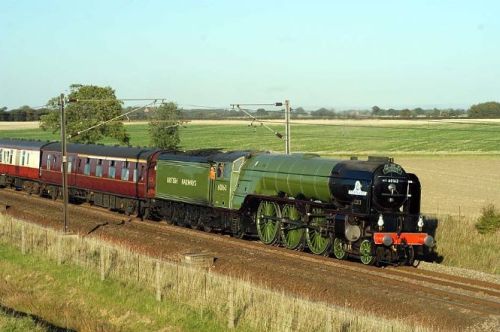
ON TOUR EXTRA: More on packing
Following the ON TOUR article on packing in last week's AERBT, George Horsley whose company supplies specialist hygiene products to the airline industry, and typifies the broad range of our readers, has supplied us with some tips he picked up in a book written by a valet for packing men’s suits.
Lay the trousers out flat with the seams together.
Place the first pair of trousers across the length of the suitcase with the trouser band just inside the case and the legs hanging out at the other end.
Repeat the process with the second pair of trousers but from the other side of the case.
If you are packing more than two pairs of trousers continue the process but spreading the trousers across the depth of the case.
Next take the jackets, lay flat with the front uppermost.
Make sure the button holes are lined up with the buttonholes but are not secured.
Fold the arms of the jacket across the front of the jacket in a diagonal direction.
Fold the jacket in half at the waist and place on top of the trousers.
Subsequent jackets should be folded in the same manner but when placed on top of the preceding jacket the fold is on the opposite side.
When this exercise is completed fold the trousers over the jackets and smooth out any creases.
Fold the trousers over the jacket alternatively from each side of the case.
This method of packing stops the jackets and trousers moving around and getting creased. It provides a flat area in the case and avoids the traditional pyramid?
And like the other suggestion it makes it very easy to get to items packed beneath.
OUR READERS' FINEST WORDS (All times and dates are GMT)
All comments are filtered to exclude any excesses but the Editor does not have to agree with what is being said. 100 words maximum
